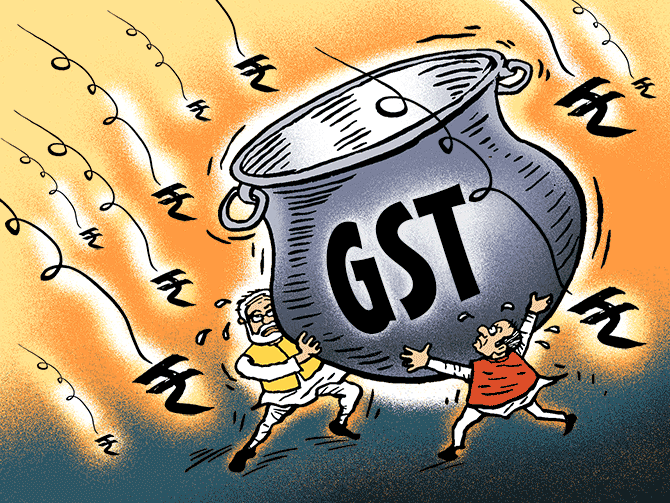For the sake of transparency, and to reduce undesirable bond market volatility, clarity on these would be welcome, preferably before the budgets for the next fiscal year get finalised, says Neelkanth Mishra.
Illustration: Dominic Xavier/Rediff.com

It is now obvious to most that getting the Goods and Services Tax (GST) started was only the beginning of the hard work, and that the first several quarters require deft manoeuvering on many fronts. Here we assess the fiscal one.
As the GST subsumed taxes that added up to 40 per cent of India’s total tax take, achieving “revenue neutrality” is critical.
That is, it must deliver taxes equal to what had been budgeted by the Centre and the states under taxes it replaced.
If it delivers more than that, it would have caused fiscal tightening, slowing down the economy, because government spending cannot rise quickly.
Conversely, less than budgeted taxes would mean fiscal easing, and an inadvertent fiscal stimulus to the economy.
For this, the two questions that matter are: what is the revenue neutral level of tax collection, and are the first four months of GST collections above or below the required run-rate?
For those outside the government, the answer to even the first question is not clear.
Credit Suisse estimates Rs 10.6 lakh crore were budgeted by the Centre and the states in this fiscal year under taxes subsumed by the GST.
But this involves making several assumptions, even for central taxes, where at least some budgetary assumptions are available.
For the states, one must trawl through individual state budgets in disparate formats, as the Reserve Bank of India’s (RBI’s) compendium of state budgets gets published only 15 months after the budgets are presented.
Even then one does not know, for example, how much of the states’ sales tax projections were for petrol, diesel or alcohol -- items that are not part of the GST.
Or the entry taxes budgeted by municipal corporations.
Recently released data shows that state governments received Rs 1.55 lakh crore in the first four months (Rs 4.8 lakh crore annualised).
This has to be at or above the revenue neutral estimate for state governments, as it includes compensation paid for revenue shortfall.
Given that the Centre and the states are by design to get the same revenue (CGST equals SGST at every point of taxation), the Centre should have the same target.
The total thus comes to Rs 9.6 lakh crore, Rs 1 lakh crore lower than our estimate, emphasising the challenges in this exercise.
The answer to the second question is even trickier. Just multiplying collections of the first four months by three to annualise them would get us to Rs 10.8 lakh crore.
Making adjustments for seasonality, we get to Rs 11.2 lakh crore.
But there are other distortions in the first four months that are harder to adjust for, some of which have inflated the run-rate, and some have deflated it.
Let us start with the tax in inventory, like in work-in-process goods in factories, or products in warehouses or retail stores.
For example, 90 per cent of the tax on a bar of soap sitting in a retail store would have been paid (that is, on the retail price minus retailer margin).
After the GST roll-out on July 1, during the time that this tax-paid inventory accumulates, the revenue run-rate would be overstated.
On the other hand, the GST is an activity-based tax, and activity levels were subdued till mid-August, as businesses adjusted to the new regime.
Further, many businesses were back-dating invoices (that is, using an invoice date of June for sales made in July), particularly in categories where tax rates went up.
Lastly, trouble in filing returns also slowed down collections: The number of GST returns filed for July and August was 5.9 million each, 50 to 60 per cent higher than on the first deadline.
The government has not yet disclosed the additional revenues from people who filed late in prior months.
Then there is compliance: Anecdotal evidence suggests it has gone up but officials say that in the first year of a new tax in any country compliance is generally lower than where it stabilises.
This is because authorities take time to plug loopholes but alert taxpayers have the incentive to find and exploit them.
The most recent government press release on the GST talks about it being a “self-declared” tax without any checks from invoice-matching, reverse charge or e-way bill (all have been postponed for a year).
At this point it is worth clarifying that contrary to a commonly held view, most businesses pay “net” tax: They do not pay “gross” tax and then wait for credit.
Only exporters are among the few that need to claim refunds.
On balance, total GST collections appear to be running ahead of revenue neutrality, and as the GST Council gets comfort on the same, more rate cuts (like the ones announced a month ago) would be necessary.
Several questions remain open though: What is the revenue neutral threshold?
Does the large unallocated IGST (nearly Rs 1.2 lakh crore as of end-November) reflect challenges in allocating to CGST and SGST?
Can this tax be used by the central government for this year’s budget?
For the sake of transparency, and to reduce undesirable bond market volatility, clarity on these would be welcome, preferably before the budgets for the next fiscal year get finalised.
Neelkanth Mishra is India Equity Strategist for Credit Suisse.











